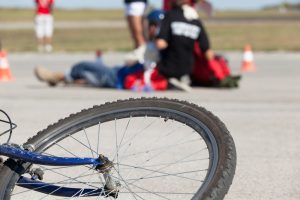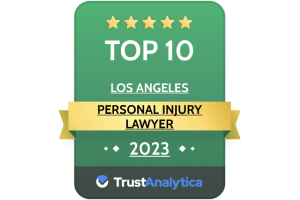- Free Consultation: 866-966-5240 Tap Here To Call Us
The Top Five Bicycle Accident Scenarios and How to Avoid Them

Bicycling is an increasingly popular mode of transportation and recreation, offering numerous health and environmental benefits. However, it also comes with its own set of risks, particularly when sharing the road with motor vehicles. Understanding common bicycle accident scenarios and how to avoid them is crucial for ensuring safety. Here, we outline the top five bicycle accident scenarios and provide practical tips on how to prevent them.
1. The Right Hook
Scenario: A “right hook” occurs when a vehicle passes a cyclist on the left and then makes a right turn, cutting off the cyclist’s path. This can happen at intersections or driveways and often results in the cyclist crashing into the turning vehicle or being forced off the road.
How to Avoid It:
- Be Visible: Wear bright clothing and use lights, even during the day, to make yourself more visible to drivers.
- Take the Lane: In some situations, it may be safer to ride in the center of the lane rather than to the far right. This can prevent cars from trying to squeeze by you before turning.
- Watch for Turn Signals: Always keep an eye on the turn signals of the vehicles around you. If a car is indicating a right turn, be prepared to slow down or stop.
- Avoid the Blind Spot: Do not ride in the blind spot of a vehicle. If you can’t see the driver’s eyes in their mirrors, they likely can’t see you either.
2. The Door Prize
Scenario: This scenario involves a cyclist crashing into an open car door. It typically happens when a parked car occupant opens the door without checking for approaching cyclists, leading to a sudden and often severe collision.
How to Avoid It:
- Ride at a Safe Distance: Maintain a distance of at least three feet from parked cars to avoid being in the “door zone.”
- Be Alert: Look for signs that someone might be about to open a door, such as a car that has just parked or brake lights turning off.
- Educate Drivers: Advocacy for public awareness campaigns can help educate drivers about the importance of checking for cyclists before opening their doors.
3. The Left Cross
Scenario: A “left cross” occurs when an oncoming vehicle makes a left turn in front of a cyclist who is going straight. The driver either does not see the cyclist or misjudges their speed, resulting in a collision.
How to Avoid It:
- Increase Visibility: Use front lights, even during the day, and wear bright clothing to increase your visibility to oncoming traffic.
- Ride Defensively: Be prepared to brake or swerve if a car appears to be turning left in front of you.
- Eye Contact: Whenever possible, make eye contact with drivers to ensure they see you before they make their turn.
- Use Hand Signals: Signal your intentions clearly when approaching intersections to let drivers know you are continuing straight.
4. The Overtaking Collision
Scenario: This type of accident happens when a vehicle overtakes a cyclist too closely, sometimes clipping them or forcing them off the road. It is particularly dangerous on narrow roads with little shoulder space.
How to Avoid It:
- Claim Your Space: On narrow roads, it may be safer to ride further into the lane to encourage drivers to pass you with a wider berth.
- Use Rear Lights: Rear lights, especially flashing ones, can make you more visible to drivers approaching from behind.
- Mirror Use: Consider using a rear-view mirror to keep an eye on traffic behind you, giving you more time to react if a vehicle is approaching too closely.
- Avoid High-Risk Areas: If possible, choose routes with wider shoulders or designated bike lanes.
5. Intersection Collisions
Scenario: Intersections are hotspots for accidents due to the complexity of traffic movements. Cyclists can be hit by vehicles running red lights, making unexpected turns, or not yielding the right of way.
How to Avoid It:
- Follow the Rules: Obey all traffic signals and signs. Do not assume drivers will stop at red lights or stop signs.
- Be Predictable: Always signal your turns and intentions clearly. Avoid sudden movements that drivers might not anticipate.
- Look Twice: Before crossing an intersection, look left, right, and left again. Be especially cautious of vehicles that may be running red lights.
- Stay Out of Blind Spots: Avoid stopping directly alongside a vehicle where the driver might not see you, especially large trucks and buses.
Conclusion
Bicycle accidents can have serious consequences, but many are preventable with the right precautions. By being visible, predictable, and aware of common accident scenarios, cyclists can significantly reduce their risk of accidents. It’s also crucial for drivers to be educated about sharing the road safely with cyclists.
For cyclists in Los Angeles seeking legal assistance after an accident, a bicycle accident lawyer in Los Angeles can provide valuable support and guidance. Remember, safety on the road is a shared responsibility, and by working together, we can create a safer environment for everyone.
Additional Tips for Cyclists
- Regular Maintenance: Ensure your bicycle is in good working condition. Regularly check brakes, tires, and lights.
- Wear a Helmet: Always wear a helmet to protect yourself in case of an accident.
- Stay Informed: Keep up with local cycling laws and regulations.
- Ride with Others: When possible, ride with other cyclists. There’s safety in numbers, and groups are more visible to drivers.
- Emergency Preparedness: Carry a basic first aid kit and know how to use it. Learn basic bike repair skills to handle breakdowns on the road.
By incorporating these safety measures into your cycling routine, you can enjoy the many benefits of bicycling while minimizing the risks. Happy cycling!












